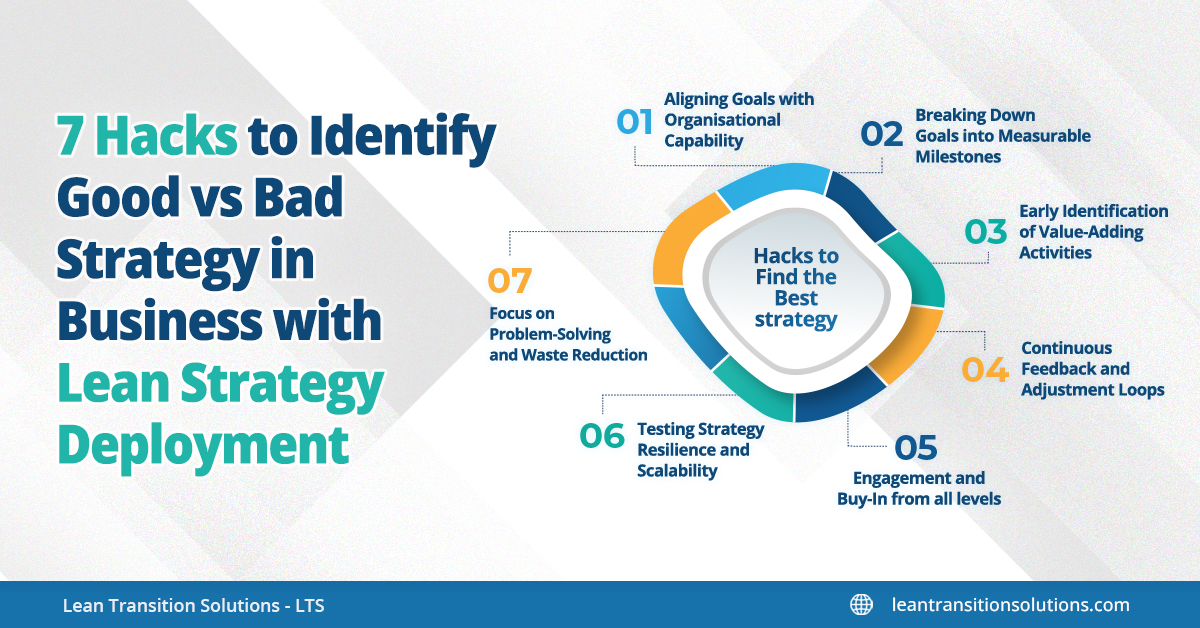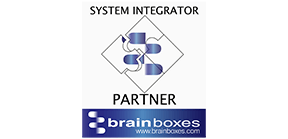7 Hacks to Identify Good vs. Bad Strategy in Business with Lean Strategy Deployment
- By Brett Griffiths
- Lean Technology
- December 05 , 2024
- Share

Have you heard of the Titanic Syndrome? Companies sinking and going out of business due to disastrous decisions is the simplest definition we can offer. One wrong move can bring your towering business tumbling down like a house of cards. Strategies can either make or break your business. Want to know how lean strategy deployment can help you check whether your strategy planning is heading in the right direction? Read along.
Two Roads Diverged in a Yellow Wood: Choose the right strategy alignment for business efficiency.
We know Robert Frost made this verse universal, and it equally applies to every business strategy planning process. At any moment, you may be caught up in discussions on the latest AI technology that could empower your business and the additional cost it brings. Or it might be about hiring new resources or opening a new outlet. With countless decisions to make, strategies shape those choices. Let’s talk, just like every time we face a tough decision, about “how to decide” or, better yet, “how to build a strategy” that drives goals into actionable results.
Bad Decisions. Wrong Data
Is it better to have a great strategy implemented badly or a bad strategy implemented well? You’ll have an answer to this by the end of this read. In both cases, “wasted potential” is something we can’t afford. (We are the lean guys, remember.) So, let’s start discussing the importance of lean strategy deployment in strategic planning. Strategy planning and decision-making can accelerate with dynamic report generation and advanced data analytics, as supported by our data-intensive platform, Data Point.
How to differentiate a Good Strategy from a Bad Strategy with Lean Strategy Deployment?
Lean strategy deployment plays a critical role in uncovering the potential of a strategy by breaking down high-level goals into actionable, measurable steps and continuously refining them based on real-time feedback. Here’s how this structured approach helps in identifying a strategy’s true potential:
Aligning Goals with Organisational Capability
Breaking Down Goals into Measurable Milestones
Early Identification of Value-Adding Activities
Continuous Feedback and Adjustment Loops
Engagement and Buy-In from all levels
Testing Strategy Resilience and Scalability
Focus on Problem-Solving and Waste Reduction
Lean strategy deployment ensures that goal setting processes are not only ambitious but also realistic and aligned with the organisation's actual capabilities. By involving leaders and key stakeholders at all levels, the process identifies any misalignment early, ensuring the strategy is achievable and relevant.
How this reveals potential: Through early alignment, leaders can evaluate if the strategy fully leverages the organisation's strengths and adjust it to better capitalise on available resources and capabilities.
By translating high-level goals into specific, time-bound objectives, lean strategy deployment provides a clearer view of whether each strategic element is achievable and sustainable. These milestones offer checkpoints that reveal progress and potential for success along the way.
How this reveals potential: Milestones create benchmarks for success, allowing leaders to gauge the effectiveness of the strategy over time and adjust if results fall short.
Lean deployment emphasises value stream mapping, where every activity in the process is analysed for its contribution to the end goal. This analysis helps identify which components of the strategy add the most value, allowing resources to be focused on the highest-impact areas.
How this reveals potential: By zeroing in on high-value activities, organisations can quickly identify which parts of the strategy have the most potential to drive results, helping prioritise resources effectively.
Lean strategy deployment includes regular review cycles (often monthly or quarterly) to assess progress against key performance indicators (KPIs). These cycles create opportunities to evaluate what’s working, what isn’t, and where potential improvements can be made.
How this reveals potential: Continuous feedback highlights both the strengths and weaknesses of the strategy in real time, allowing leaders to refine and maximise its impact before investing too deeply in any single direction.
One of the strengths of lean deployment is its focus on engaging employees and teams at all levels. By involving team members in strategy execution, the organisation gains insights into the feasibility of the strategy from those closest to the day-to-day operations.
How this reveals potential: Employees provide direct feedback on what’s working and what needs adjustment, offering a clearer picture of the strategy’s practical impact and potential for sustained success.
Through regular refinement and goal reassessment, lean deployment tests whether the strategy can scale and adapt to changes, such as shifting market conditions or internal capacity adjustments.
How this reveals potential: By testing scalability and resilience, organisations can determine if a strategy is flexible enough to handle growth and unforeseen challenges, revealing its potential for long-term success.
Lean deployment continuously seeks to eliminate inefficiencies and optimise processes. In doing so, it helps identify and remove obstacles that may hinder the strategy’s success, refining it for peak performance.
How this reveals potential: By removing barriers and redundancies, lean deployment ensures the strategy is both efficient and resilient, setting it up for maximum impact.
Lean strategy deployment is like a lens that magnifies the potential of a strategy by providing a structured, transparent approach to assess, refine, and align objectives. Through alignment, measurable goals, ongoing feedback, and employee involvement, it helps organisations identify not only if a strategy is feasible but also how it can be optimised for maximum impact and scalability.
How Lean Strategy Deployment enables a Good Strategy and discards a Bad Strategy
Factor |
Good Strategy (Enabled by Lean Deployment) |
Bad Strategy (Discarded by Lean Deployment) |
Budget |
Aligns budget with high-impact goals, ensuring efficient spending. |
Lacks budget prioritisation, leading to wasted funds on low-value activities. |
Resource Utilisation |
Maximises resource use by focusing on value-adding activities and reducing waste. |
Misallocates resources, spreading them thin over less impactful tasks. |
Growth |
Sets realistic, scalable growth milestones, refining objectives as needed. |
Sets unrealistic growth targets without a clear path to scale. |
Risk |
Identifies and mitigates risks through regular review cycles and feedback. |
Overlooks potential risks, leading to unanticipated setbacks. |
Adaptability |
Allows for continuous improvement, adapting strategy to market changes. |
Remains rigid, failing to adjust to evolving needs or challenges. |
Employee Engagement |
Involves teams in strategy, fostering ownership and practical insights. |
Lacks team involvement, leading to disengagement and implementation gaps. |
Transform Vison to Action with Lean Approach of Business Strategy Planning
With lean strategy deployment, turning a vision into a powerful, results-driven strategy becomes achievable. By aligning high-level goals with actionable steps, lean deployment ensures every objective is value-focused, budget-conscious, and adaptable. This approach maximises resource use, continuously refines your strategy based on real-time feedback, and engages your team at every level. Say goodbye to vague plans and hello to a strategy that’s built for growth, agility, and long-term success.
Frequently Asked Questions
What is lean strategy deployment?
How can I identify a bad business strategy?
Why is identifying a good strategy important for business success?
How does lean strategy deployment improve strategy implementation?
What are the key hacks to differentiate good and bad strategies?
Lean strategy deployment is a structured approach to aligning business goals with actionable plans, ensuring efficient resource use and adaptability.
A bad strategy often lacks clear goals, alignment with resources, and measurable outcomes, leading to confusion and inefficiency.
A good strategy provides clarity, focus, and a roadmap for achieving goals, ensuring better decision-making and resource allocation.
Lean strategy deployment fosters communication, prioritises objectives, and streamlines processes, enabling smooth execution of strategies.
Key hacks include evaluating clarity of goals, feasibility, alignment with resources, adaptability, and measurable outcomes.
Start Free Trial
LEAN TRANSITION SOLUTIONS
The Old Vicarage, Pershore Road, Upton Snodsbury, Worcester, Worcestershire, WR7 4NR, United Kingdom.
BLOG
Lean Transition Solution
-
Lean Industry 4.0 Solutions
- TITAN:Computerised Maintenance Management System
- Data Point:Computerised Balanced Scorecard
- Janus: Automated Shop-floor Data Capture System
- T-Card: Integrated Production Planning and Plant Level Execution System
- JDI: Maintenance Automation App
- Maximus: Integrated ERP System
- e-Contractor: Integrated In-house Contractor Management System
- Q-Point: Integrated Quality Management System
- Safety-Point: Integrated Health and Safety Management System
- Lean Assessment: Lean Audit and Assessment System
- Saisho: Lean 5S Audit and Assessment App
- Emergency Response App: To Manage Emergency Situations
-
Leadership 4.0 Solutions
- Your Career Academy(YCA): Learning and Development System
- YCA e-Learning : Management System
- MentorYou(MU): Mentoring App
- Leadership 4.0 : Leadership Transformation Program
- Lean Manufacturing Workshop
- Lean Manufacturing Consulting
- ILM Accredited Green Belt Training and Certification Program
- ILM Accredited Black Belt Training and Certification Program
- Software Development Service
- Resources
- Company
- Contact











